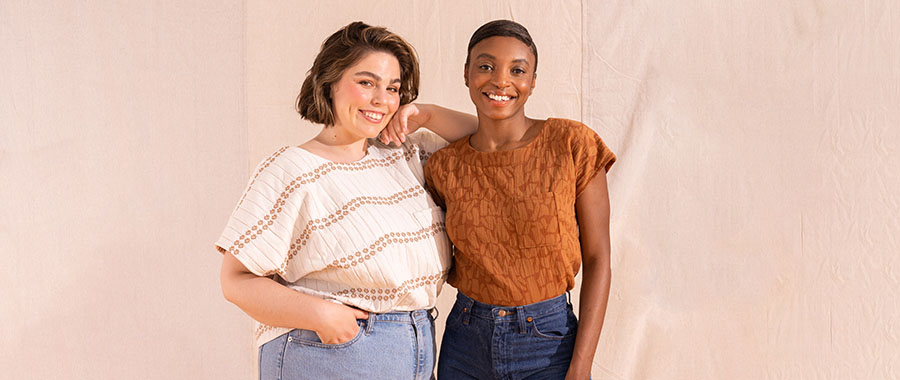In this episode of Seamwork Radio, hosts Sarai and Haley discuss how to find inspiration in vintage clothing and translate those elements into a modern wardrobe. Whether you're a sewing enthusiast or simply appreciate vintage fashion, their practical tips will help you incorporate unique details from the past into your personal style.
Where to Find Vintage Inspiration
Online Museum Collections: A Treasure Trove of Fashion History
Online museum collections provide access to thousands of historical garments with detailed descriptions of materials and techniques. The Metropolitan Museum of Art's Costume Institute features over 33,000 works in its online collection, while the Victoria and Albert Museum (V&A) offers extensive costume and textile collections.
These resources allow you to search for specific designers or eras and provide valuable context about each piece. As Haley notes, "It's nice to be able to look at these images and also have the descriptions available with them as well."
Pinterest Boards for Cataloging Vintage Details
Creating dedicated Pinterest boards for vintage details can help organize your inspiration and lead to new discoveries. The Pinterest algorithm will start suggesting similar images once you've pinned a few items in a particular style.
Sarai maintains boards for general vintage details and specific techniques like heirloom sewing, while Haley organizes her boards by application:
"I have one for sleeves. I have one for pockets. I have one for collars," Haley explains. "As a designer, I find it really helpful to catalog them that way because then when I'm designing something and I'm feeling a little uninspired, I can look for inspiration specific to design elements I'm incorporating already."
Studying Vintage Garments In Person
Nothing beats examining vintage clothing up close to understand construction techniques and details. Visit high-end vintage stores to inspect the fabrics and interior construction of garments. Haley suggests bringing a sketchbook to record interesting details after your visit.
"If you ever feel self-conscious going into stores like this, most of the people who work at those places are just as enthusiastic about vintage and all of the details as you are," Haley reassures. "They're happy usually to just be in the presence of someone who also appreciates it."
Fashion Coffee Table Books
Beautiful coffee table books featuring designers like Dior, Balenciaga, and Yves Saint Laurent provide a wealth of inspiration. Sarai recommends checking your local library or looking for used copies if you don't want to invest in expensive fashion books.
Vintage sewing technique books can also be invaluable. Haley shares: "Recently, I was looking at one and there was hand-picked patch pockets for outerwear projects. I found that to be really inspiring and got me thinking about upcoming designs or projects where I could incorporate that detail."
Translating Vintage to Modern
Finding Your Favorite Fashion Era
Both hosts share their favorite fashion decades: the 1930s and 1970s. Sarai loves the 1930s for its bias cuts and sleek lines, while Haley appreciates the innovative details born from fabric conservation during the Great Depression.
For the 1970s, Sarai notes, "We started to see a lot more tailoring and masculine influences in women's clothing in a way you hadn't necessarily seen before." Haley adds that 70s styles are "really wearable and easy to incorporate vintage pieces into my wardrobe."
Make vs. Buy: A Sustainability Perspective
When deciding whether to buy vintage or create your own vintage-inspired pieces, both hosts consider sustainability. Haley tries to find secondhand items first: "It's always the most sustainable thing to consume what already exists out there."
Sarai takes a different approach, aiming to build a wardrobe that's 80% handmade to reduce overall consumption: "It's not so much because I think that's necessarily the more sustainable choice on a piece-by-piece basis, but it'll lead me to consume less overall and to have less that I have to take care of and manage."
Using Inspiration, Not Just Collecting It
The most important step is actually using the inspiration you've gathered. Instead of endlessly collecting ideas, choose one detail or technique to incorporate into your next project.
"Maybe it'll inspire a totally new project or maybe you can incorporate it into something you were already planning on sewing," Haley suggests. "The point is to just use it."
Final Thoughts
Varying your sources of inspiration keeps your creative process fresh and motivating. As Haley points out, "If you're just looking at the same old thing and recreating the same old thing over and over again, you might find that your motivation runs dry a little bit faster."
Sarai emphasizes the importance of creating rather than just collecting: "Even though I love collecting inspiration, getting ideas, sketching, all that stuff, I want to make sure that I'm actually using it to create and spending my time creating more than I am just gathering."
By incorporating vintage details into modern designs, you can create unique, high-quality garments that stand out from mass-produced fashion while connecting to the rich history of clothing design.
